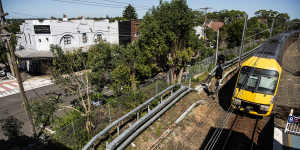Council documents and statements from mayors indicate the government will give certain councils up to six more months to make alternative plans to accommodate housing growth in other ways,or in different parts of their municipalities.

Roseville is one of four north shore line stations earmarked for higher density under the government’s transport-oriented development program.Steven Siewert
Planning Minister Paul Scully confirmed he would offer deferrals where councils were working on their own schemes,but they would need to deliver more homes than the government’s. The length of the deferral “depends on the circumstances” but “we’re not doing wholesale delays”,he said.
“It’s not about going backwards from where the[government’s policy] would get you to,it’s about going beyond,” Scully said. “We’re going through what councils have provided us,and we’ll have more to say on that.”
Ku-ring-gai Council has four stations affected by the program – Roseville,Lindfield,Killara and Gordon – and held a series of meetings with Scully and department officials in the past month. According to council management’s written summary of those discussions:

“We’re not doing wholesale delays”:Planning Minister Paul Scully confirmed some deferrals would be possible.Kate Geraghty
That differs from,which said the new planning controls would begin at all 31 stations in April,and remain in place “until councils have finalised their strategic planning in ways that align with the NSW government[’s] policy objectives”.
While Ku-ring-gai Council staff recommended revising the council’s housing strategy to deliver more homes,elected councillors rejected that option. Instead,they resolved to condemn the Minns government for its “irresponsible approach to planning”,and authorised the general manager to implement actions outlined in a confidential document “if required”. That is believed to be a legal challenge.
But other councils are likely to take up the deferrals. Labor mayor of Burwood John Faker,who is against Croydon’s inclusion in the scheme because it could impact nearby heritage conservation areas,said he expected to reach agreement with the government about an extension.
“I think we’re going to end in a good place,” he said. “[Scully] has been very open and responsive. I believe we will be hearing something in the next couple of weeks.” Faker said it would be likely to take nine to 12 months for his council to investigate alternative options for housing growth.

A six-month deferral for some stations could reduce the political heat of the issue until after September’s council elections. But Scully denied that was a factor.
“If the government wanted to avoid conflicts with councils before a council election,we would not have done this at all,” he said. “The dates will be the dates,and announcements will be made with respect to the finer detail in due course.”
The 31 suburbs were chosen by the Planning Department following an analysis of infrastructure,zoning and feasibility around 305 stations in Sydney,Newcastle and Wollongong. Combined,they were expected to yield up to 138,000 new homes over 15 years. That equates to an average of just under 300 homes a year at each location.
That would be achieved by changing planning controls within 400 metres of train stations to allow apartment blocks up to six storeys,no matter how the land is currently zoned. It would also discard minimum lot sizes and introduce a 3:1 floor space ratio.
,the program is part of a package of state government interventions to boost housing supply. But it has attracted opposition from some councils and community groups who call it an unwarranted incursion into local planning.
Inner West Council has several stations in the TOD program – Ashfield,Dulwich Hill,Marrickville and part of Croydon – and Labor mayor Darcy Byrne said he was having “constructive discussions with the minister” about those as well.
There have already been numerous failed attempts to provide more housing around those stations. In 2018,the Coalition government abandoned the Sydenham to Bankstown corridor urban renewal strategy,which would have rezoned land along the Metro line for up to 36,000 new homes,after a community and council backlash. The government returned those powers to individual councils.
In 2022,Inner West Council halted work on rezoning land near Marrickville,Ashfield and Dulwich Hill stations after residents complained. The work was never completed.
Scully said he was confident any deferrals would not lead to the system being “gamed” this time,as the policy would set a new minimum standard. “While you might defer the commencement date for a short period … if the additional work doesn’t result in the expected outcomes or is not done,then that new standard applies,” he said.
Separately,the government is continuing with the other arm of its transport-oriented development program – the state-led rezoning of eight major train and metro station precincts:Bankstown,Bays West,Bella Vista,Crows Nest,Homebush,Hornsby,Kellyville,Macquarie Park.
Start the day with a summary of the day’s most important and interesting stories,analysis and insights..